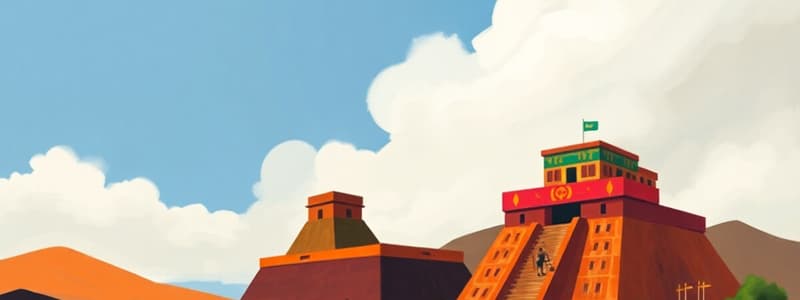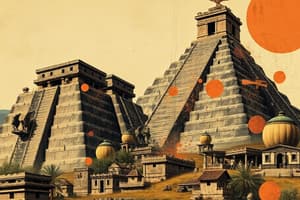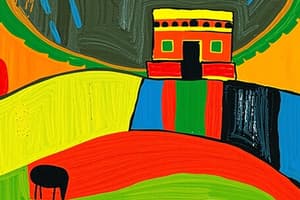Podcast
Questions and Answers
The Inca Empire included which of the following countries?
The Inca Empire included which of the following countries?
- Ecuador
- Peru
- Bolivia
- All of the above (correct)
What is Inti considered to be
What is Inti considered to be
The god of the sun
The Incas did not use freeze-dried potatoes (chuños) as insurance against food shortages.
The Incas did not use freeze-dried potatoes (chuños) as insurance against food shortages.
False (B)
What did German scientist Alexander Humboldt say quinoa was to the Greeks?
What did German scientist Alexander Humboldt say quinoa was to the Greeks?
Which of the following crops is a staple of the 'three sisters farming' technique?
Which of the following crops is a staple of the 'three sisters farming' technique?
What is the name of the capital city Aztecs built?
What is the name of the capital city Aztecs built?
What is Chicha
What is Chicha
The word ______ was first used to describe any grain, like barley or wheat.
The word ______ was first used to describe any grain, like barley or wheat.
What does America call corn on the cob
What does America call corn on the cob
Where did Chile peppers originate??
Where did Chile peppers originate??
Sugar cane originated in the Americas?
Sugar cane originated in the Americas?
What were blankets from smallpox patients used for in the late 1800s?
What were blankets from smallpox patients used for in the late 1800s?
What is the estimated pre-contact population of Native Americans?
What is the estimated pre-contact population of Native Americans?
Slavery was never practiced in British North America (now called Canada)
Slavery was never practiced in British North America (now called Canada)
What action did Upper Canada (now Ontario) take as early as 1793?
What action did Upper Canada (now Ontario) take as early as 1793?
The Upper Canada (now Ontario) was a what for escaping slavery.?
The Upper Canada (now Ontario) was a what for escaping slavery.?
What beverage is associated with the Old World ingredients of Paella?
What beverage is associated with the Old World ingredients of Paella?
Flashcards
Inca and Gold
Inca and Gold
The Inca Empire in South America referred to gold as 'the sweat of the sun'.
Terraced Farming
Terraced Farming
An agricultural technique where slopes are cut into steps to create level fields.
Quinoa
Quinoa
A grain native to the Andes, high in protein.
Potato Origin
Potato Origin
Signup and view all the flashcards
Chuños
Chuños
Signup and view all the flashcards
Early European Potato Fears
Early European Potato Fears
Signup and view all the flashcards
Antoine-Auguste Parmentier
Antoine-Auguste Parmentier
Signup and view all the flashcards
Squash Origin
Squash Origin
Signup and view all the flashcards
Three Sisters Farming
Three Sisters Farming
Signup and view all the flashcards
Tenochtitlan Location
Tenochtitlan Location
Signup and view all the flashcards
Vanilla
Vanilla
Signup and view all the flashcards
Corn vs. Maize
Corn vs. Maize
Signup and view all the flashcards
Huitlacoche
Huitlacoche
Signup and view all the flashcards
Cacao
Cacao
Signup and view all the flashcards
Chile Peppers Origin
Chile Peppers Origin
Signup and view all the flashcards
Cahokia
Cahokia
Signup and view all the flashcards
Triangle Trade
Triangle Trade
Signup and view all the flashcards
Slavery in Canada
Slavery in Canada
Signup and view all the flashcards
Melting Pot
Melting Pot
Signup and view all the flashcards
The Columbian Exchange: Incoming
The Columbian Exchange: Incoming
Signup and view all the flashcards
Diversity
Diversity
Signup and view all the flashcards
July 4, 1776
July 4, 1776
Signup and view all the flashcards
The Columbian Exchange: Outgoing
The Columbian Exchange: Outgoing
Signup and view all the flashcards
Northeast Specialties
Northeast Specialties
Signup and view all the flashcards
Southern Specialties
Southern Specialties
Signup and view all the flashcards
Midwest Specialties
Midwest Specialties
Signup and view all the flashcards
Southwest Specialties
Southwest Specialties
Signup and view all the flashcards
Beverages of the USA
Beverages of the USA
Signup and view all the flashcards
Celebrations of the USA
Celebrations of the USA
Signup and view all the flashcards
Alcoholic Brews
Alcoholic Brews
Signup and view all the flashcards
Study Notes
- The Americas include South and Central America, and the USA.
- Understanding the impact of pre-Columbian foods is vital to understanding the impact of world cuisine on North America.
Pre-Columbian America
- Pre-Columbian America has three main divisions: The Inca, The Aztecs and Mayans, and The Cahokia.
The Inca
- The Inca Empire, located in South America, included Ecuador, Peru, Bolivia, Chile, Columbia, and Argentina.
- Gold was very important: Inti, the god of the sun, was represented by gold, referred to as “the sweat of the sun”.
- Walls and buildings were once covered in sheets of gold which were then melted down by the Spanish conquistadores.
- Machu Pichu was discovered in 1911.
- The Inca domesticated potatoes between 3700 and 3000 BC.
- They used over 4,000 varieties of potatoes, and forbade peeling.
- Freeze-dried potatoes (chuños) were invented as insurance against food shortages
- Root crops were a significant source of carbohydrates.
- Potato captured world attention, though protein shortages were not uncommon.
- After the conquest of the Inca Empire, the Spanish brought the potato to Europe in the 16th century.
- Europeans regarded potatoes with skepticism, suspecting they caused ailments such as leprosy and sterility.
Potato Adoption
- Acceptance of the potato gradually increased, and potatoes became widely cultivated in the US by 1719.
- In 1771 France, Antoine-Auguste Parmentier, a chemist and botanist, studied the potato's famine-relieving properties.
- Parmentier then persuaded Louis XVI to grow potatoes in secured fields.
- French farmers took advantage of a deliberate pause in security, stealing potatoes to grow them on their own land.
Squash
- Squash originated in Bolivia and surrounding areas as early as 500 BC.
- Many varieties of squash don't exist outside South America.
- The male squash blossom is used in cooking.
Fruit
- Various fruits indigenous to the Andes are slowly becoming more common in North America Some of these fruits include cape gooseberries, pepino, tamarillo, and cherimoya.
- The giant Colombian blackberry and inga pods (or ice cream bean) also originated in the Andes area.
Quinoa
- Quinoa is referred to as the 'mother grain'.
- It is native to the Andes, high in protein, and considered a good source of protein for vegetarians.
- In the 1800s German scientist Alexander Humboldt compared quinoa to wine for Greeks, wheat for Romans, and cotton for Arabs.
- Quinoa is resilient to droughts and poor soil, and could boost global food security, according to the UN's Food and Agriculture Organization.
The Aztecs and Mayans
- Mayans farmed efficiently, combining corn, beans, and squash referred to as the 'three sisters farming'.
- They did this to avoid the time-consuming task of spreading fields apart.
- Corn stalks grew straight, acting as a trellis to support beans, and the large leaves of the squash plant kept moisture in the soil.
- Bees also appeared throughout the Mayan codices; cinnamon, cloves, nutmeg, and allspice were used for seasoning.
- Aztecs built their capital, Tenochtitlan, on an island in the middle of a lake, following a spiritual sign.
- Aztecs were powerful, skilled engineers who built roads above the lake water, and drained swamps.
- Aztecs also invented chinampas, which were land and irrigation ditches that looked like floating fields.
Vanilla
- Vanilla is the only edible member of the orchid family.
- It originated in the lowland tropical forests of Central America and the northern part of South America.
- Vanilla was used to perfume temples, as Europeans did in the Middle Ages with cinnamon.
- Vanilla grows on vines that climb supporting trees, called 'tutor' trees.
- The vanilla flower opens for at most 8 hours and needs hand-pollinating, after which it never opens again.
- Nine months after pollination, the vine produces long green pods.
Corn
- Corn was originally used to describe any grain, like barley or wheat.
- Maize, the American term for corn on the cob, comes from the Spanish who learned it from the Caribbean indigenous tribes.
- It was domesticated in central Mexico by 3400 BCE.
- Corn became a basic crop that spread north into the American southwest and south to the Inca empire.
- Chicha is a corn beer.
- "Mexican Truffles"/Huitlacoche is a delicacy: a fungus that grows on the ear of the corn, starts out white, and turns black.
Forms of Corn
- Cornmeal
- Hominy: used for masa harina
- Grits
Cacao Tree
- The cacao tree was very important to the Maya.
- It came from the Maize God's body.
- Drinking chocolate was the beverage of nobles, warriors, and emperors in Aztec society.
- It was served after banquets with tobacco to smoke for bonding.
Chile Peppers
- Chile peppers are #1 spice in the world.
- They originated in Bolivia 7,000 years ago and domesticated 4,000 years ago.
- The Inca, Maya, and Aztecs seasoned their food with chile peppers.
- After the Columbian Exchange, many cultivars of chili peppers spread across the world, used for both food and traditional medicine.
- China is currently the #1 producer, responsible for half the world supply.
- Chile peppers were brought to Spain in 1493, and their medicinal effects written about.
- Chilies were initially grown as curiosities in monasteries.
- Christian monks experimented with the culinary potential of chile peppers.
- Pungency offered a substitute for black peppercorns.
- Chili peppers spread to Asia with Portuguese traders.
- Spice trade routes were then dominated by the Portuguese and Arab traders.
- Introduced in India by the Portuguese towards the end of 15th century.
- Today chilies are integral to Indian and Southeast Asian cuisines.
North America: Cahokia
- In pre-Columbian North America, a city of huge pyramids rose from the flat lands on the banks of the Mississippi River in 700 CE, just east of present day St. Louis.
- The Cahokia pyramids consisted of 100 flat top pyramid mounds, aligned with the rising and setting sun, and constellations.
- Cahokia reached a population of between 10,000 and 20,000.
- By 1250 it was larger than London, England.
- It is believed that the city was wiped out by European diseases spread by the Spanish from Mexico.
- By the time Americans reached the Mississippi in 18th century, Cahokia was a ghost town.
- This would happen to Inca, Aztecs and other indigenous peoples.
Common Native American foods
- Succotash
- Bean Bread
- Fry Bread
- Baked Acorn Squash
- Fish and Corn Mush
- Baked Beans
The Columbian Exchange
- Standard aboard Spanish ships: The crew ate mostly dry and salted food, Spanish food.
- Rice and dried chickpeas, beef and pork, anchovies and sardines preserved with salt were common.
- Casks of olive oil and wine were brought to provide each man with 1 1/2 liters ration each day.
- Hardtack - unleavened, rock-hard flour, water and salt biscuit was more hospitable to weevils & parasites.
- Supplemented with any fresh fish they caught.
- Dried fruit, if any, was for the officers, while enlisted men had no vegetables.
- There was no cook on board; the crew took turns cooking the midday meal over a fogon, an open iron box
The Triangle Trade
- Caribbean: the exchange of sugar and rum from Caribbean to Europe, goods from Europe to Africa, and enslaved people from Africa to the Caribbean.
- American: the exchange of Molasses shipped from the Caribbean to New England to be processed into rum.
- This rum was then traded for enslaved people in Africa, who were brought and sold in the Caribbean.
United States Key Historical Facts
- The 13 colonies became the USA
- Founding Fathers: G. Washington, J. Adams, T. Jefferson, J. Madison, A. Hamilton, J. Monroe, B Franklin
- Founded July 4, 1776, Independence Day.
- American Revolution: April 1775-1783.
- Declaration of Independence (Thomas Jefferson) drafted June 1776, and delivered to Great Britain November 1776
Key Dates In History
- 1812: war against British attempting to cut off supllies to French.
- 1861-1865: Civil war - State rights vs. federal rights, slavery, abolitionism.
- World War I & II
- 1960 Civil Rights Movement: 1964 segregation stopped.
- 1961 Cuba and U.S.A. – nuclear conflict climax of the Cold War
- 1961: man in space.
- 1963: Death Of John F. Kennedy.
- 1962: Vietnam war.
Slavery in British North America
- Slavery was practiced throughout North/South America and the Caribbean from the 1500's through 1800's, including in British North America.
- More than 4,000 enslaved people of African descent were forcibly brought to lands that are Canada today.
- As early as 1793 Upper Canada (now Ontario) passed an act to gradually end slavery.
- The Slave Trade was abolished across the British Empire in 1807.
- Slavery was abolished by 1834 in the British Empire.
- As a country that abolished slavery, Upper Canada (now Ontario) was a destination for escaping slaves.
- Windsor, Kingston & Niagara were all a terminus of the underground railroad
- 30-40 thousand formerly enslaved African Americans reached Canada (1800 – 1860).
- Buxton Ontario is an Underground Railroad community deemed the most successful of all for Black refugees escaping slavery in the United States.
The Melting Pot
- A time of rapid infusion of people from all around the world.
- Includes exposure to a wide diversity of religions.
- A broadening of the holiday specturm.
- Regional distinctions in food specialties are fading.
- "Fusion" food is the norm
- A gap exsits between urban and rural settings.
Regional Cuisine
- Northeast: Native Americans, Pilgrims, British Isles
- Southern: England, Africa, France, Spain, Caribbean
- Midwest: Britain, Scandinavian, German, Italian
- Southwest: Spanish, Mexico
Studying That Suits You
Use AI to generate personalized quizzes and flashcards to suit your learning preferences.




